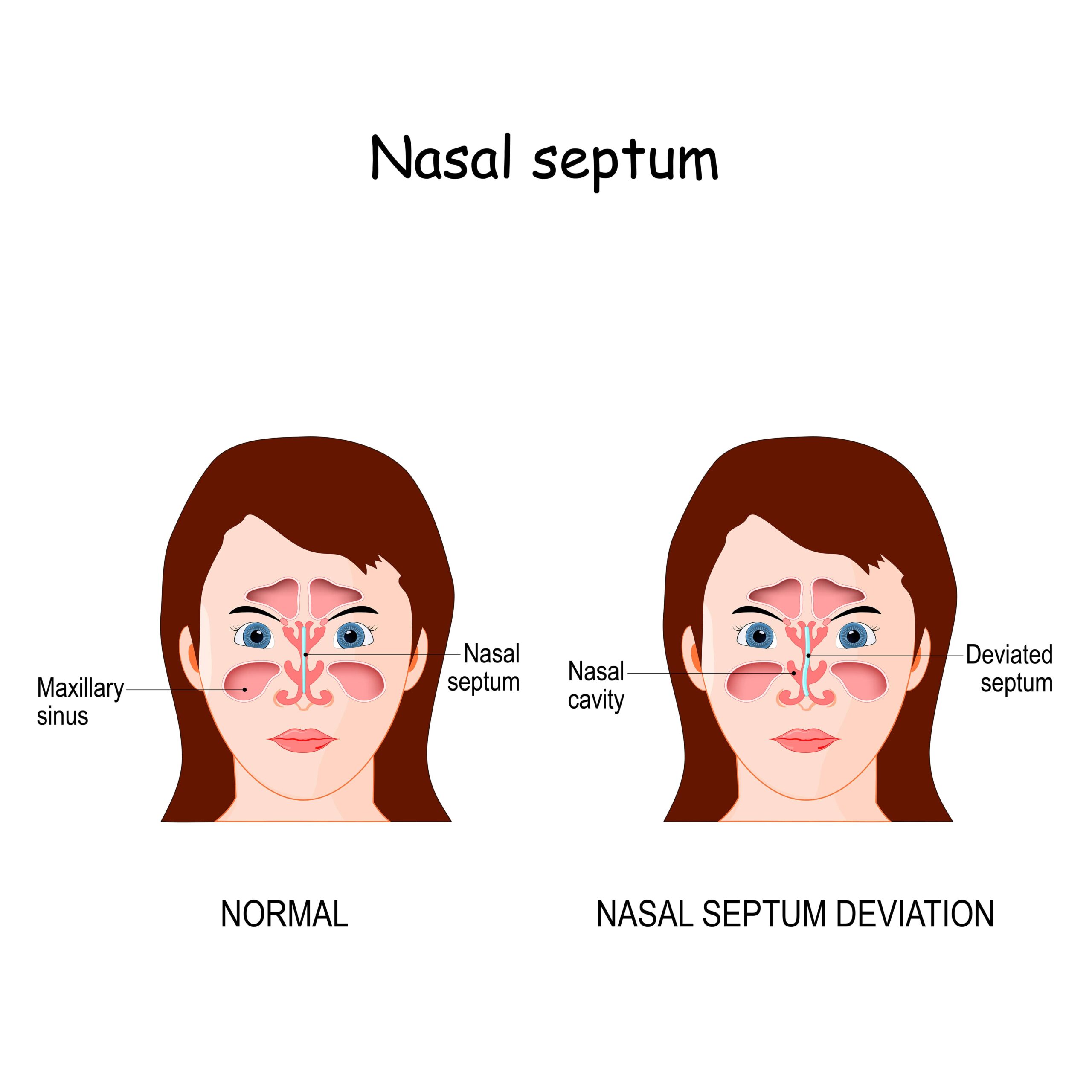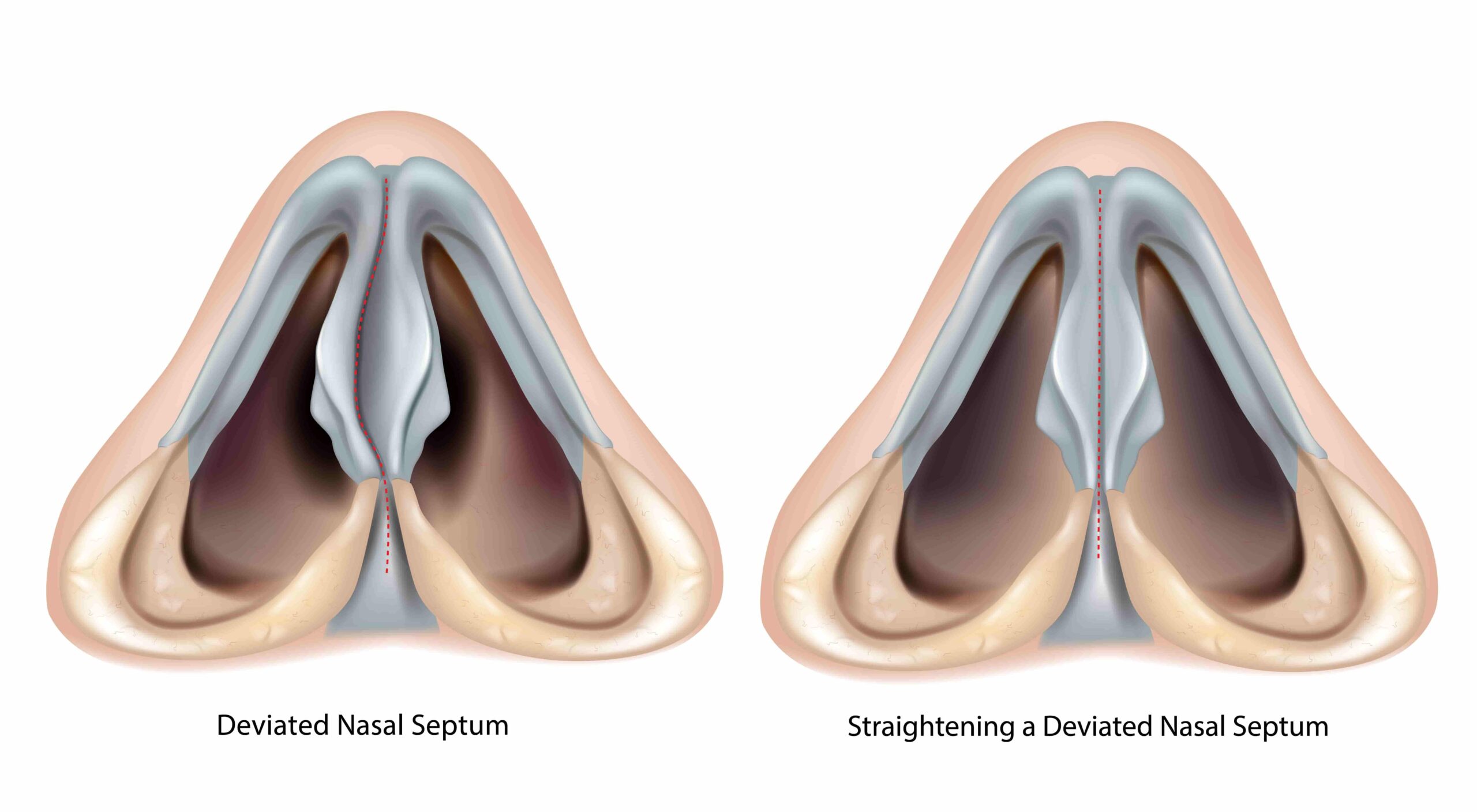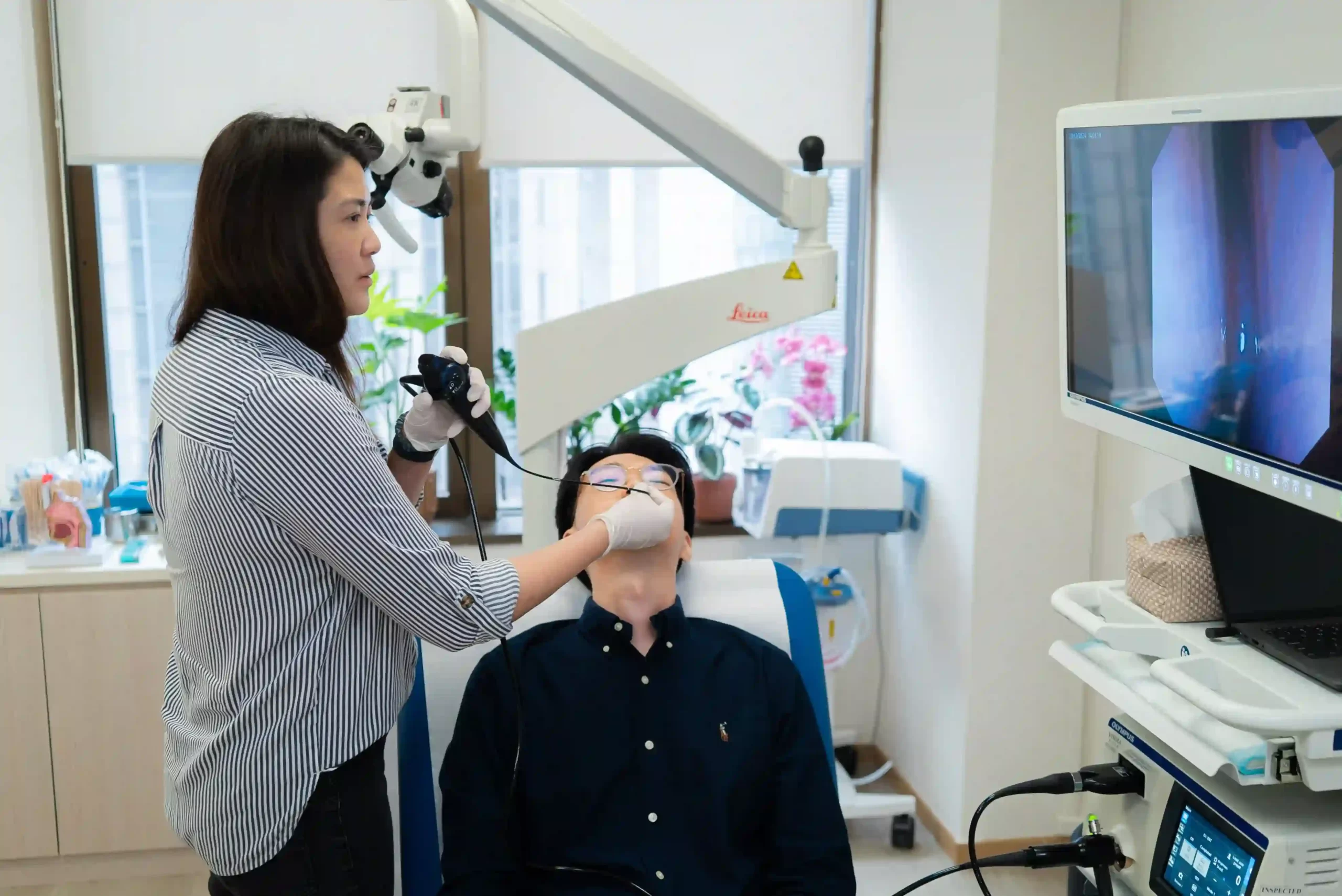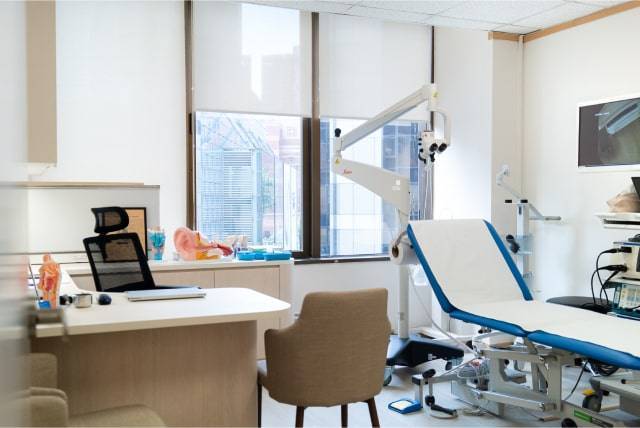Septoplasty

Have you ever experienced difficulty breathing for no apparent reason? You might have a deviated septum. This means that the barrier between your nostrils is crooked, making one of your nasal passages significantly smaller than the other. At Aglow ENT Centre, our nose specialist in Singapore can provide a proper diagnosis and offer treatment recommendations, such as day surgery to correct your nose and improve your breathing.
What is Septoplasty?
Septoplasty, also known as a deviated nasal septum surgery, is a minor surgical procedure performed to straighten a crooked nasal septum, which is the wall of bone and cartilage separating the space between the two nostrils. A bent nasal septum could either be a condition that was present at birth and worsened over time or a result of trauma. While some septum deviation is normal, severe symptoms like difficulty breathing, frequent nosebleeds, sinusitis, and persistent headaches can lower patients’ quality of life, often necessitating surgery.
By nature, septoplasty is minimally invasive, with only a small incision inside the nose required at the beginning. This results in no external cuts on the face once the surgery is completed, which typically lasts for 45 minutes to an hour.

Who can perform Septoplasty?
Septoplasty is considered a minor surgery. However, due to the delicate nature of the nose, which contains many fine, small blood vessels that are prone to bleeding, the procedure is usually performed by a nose specialist well-versed in nasal anatomy. This often means visiting an Ear, Nose and Throat (ENT) specialist – also known as an otolaryngologist. You can schedule a septoplasty with an ENT specialist in Singapore who is trained to perform the surgery. Dr Ker Liang at Aglow ENT Centre is a skilled ENT surgeon with experience in conducting septoplasty procedures. It is advisable to choose a surgeon with significant expertise in performing septoplasties to ensure the best possible outcome.
What to Expect?
Before the Surgery
Prior to the surgery, patients will attend an initial consultation with their surgeon. During this session, your ENT surgeon will explain what to expect and evaluate your condition to determine if you are fit for the procedure. This may include an inspection inside your nose using nasal endoscopy (nasoendoscopy).

This is also an opportunity for doctors and patients to address specific concerns, such as allergies, existing medications and financial counselling.
If you are deemed ready for surgery, you will likely receive advice on preparation, including:
- Pausing certain medications that may make it harder for blood to clot
- Pausing smoking (if applicable) to reduce the risk of complications
During the Surgery
During the procedure, your ENT surgeon will work to reposition the deviated septum to the centre of the nose by either removing or repositioning parts of the septum. Specifically, the procedure constitutes:
- Your surgeon makes a small cut inside your nose to lift the thin tissue covering your septum.
- Once the area is exposed, the bent cartilage or bone is removed or repositioned as necessary.
- The lining will be stitched back together.
The whole procedure may take 45 minutes to an hour to complete. To prevent bleeding, your surgeon may place packing inside your nose. This packing might dissolve within a few days or be removed by your care team a few hours after the procedure.
In some instances, your surgeon may also perform a turbinate reduction (turbinoplasty) for a better outcome. This is because both procedures are aimed at improving nasal airflow in patients with significant nasal obstruction.
After the Surgery
Most patients can leave the clinic on the same day after the surgery. Subsequently, patients are encouraged to do the following after a septoplasty:
- Schedule post-operative visits every 7-14 days to ensure their nose is healing well. During these visits, your surgeon will clean and inspect the inside of your nose again via naso-endoscopy.
- Take medications as prescribed to facilitate an optimal healing process
- Do a saline rinse at least 3-4 times per day to keep your nasal passage clean. Your care team will be able to guide you on how to do a saline rinse.
- Avoid blowing your nose to prevent bleeding
- Stay away from strenuous activities such as intense exercises that could trigger a nosebleed
In the beginning, patients may feel their nose is more blocked due to swelling from the surgery. This should improve over the next 3-4 weeks as recovery progresses. Full healing of the inner lining of the nose typically takes 6-8 weeks. During the initial recovery period, it is crucial to avoid catching the flu, as it may lead to a nose infection, which hinders a patient’s recovery.
The Benefits of Septoplasty
For patients who have suffered from severe symptoms, septoplasty aims to achieve the following outcomes:
- Enhanced Breathing: Corrects a deviated septum, allowing smoother airflow through the nasal passages.
- Reduced Nasal Congestion: Helps alleviate chronic nasal blockages and congestion, making breathing easier.
- Increased Sleep Quality: Eases conditions like snoring and sleep apnoea, improving overall sleep quality.
- Decreased Sinus Infections: Reduces the frequency of sinus infections caused by impaired airflow and drainage.
- Enhanced Sense of Smell: Can restore or improve the sense of smell that may have been affected by nasal obstruction.
These benefits make septoplasty an effective treatment for some patients with structural nasal issues. At Aglow ENT Centre, your condition will be thoroughly examined by our ENT surgeon, who will advise you on whether septoplasty suits you.
What is the Success Rate of Septoplasty?
Septoplasty is a safe procedure with a high success rate in Singapore. It is important to note that your surgeon is unlikely to recommend this procedure if the perceived risks outweigh the potential benefits for patients. In most cases, patients who went for a septoplasty experience an improvement in their breathing after full recovery. To ensure the best possible outcome, make sure that you consult with an ENT specialist who is trained for this procedure.
What are the Potential Risks and Complications of Septoplasty?
As with any other surgical procedure, there are potential side effects. Some of the common observed side effects after a septoplasty include:
- Nasal congestion
- Minor bleeding
- Mild discomfort or pain
- Numbness affecting the upper front teeth
These risks are usually mild and temporary, typically resolving on their own. They could be minimised in the hands of an expert ENT specialist. At Aglow ENT Centre, our experienced ENT surgeon, Dr Ker Liang will provide the necessary guidance post-surgery to facilitate an optimal recovery with minimal side effects.
When is a Septoplasty Necessary?
While a slightly off-centred septum is common and usually harmless, a severely deviated septum can significantly impact the quality of life. Patients with severe, chronic symptoms such as nasal congestion or difficulty breathing, may also experience frequent sinus infections. This occurs because nasal blockages can create an environment for bacteria to thrive, leading to infections.
In such cases, surgery to correct the deviation may be recommended, particularly for patients who have tried medication without seeing improvement in their symptoms.
You can book an appointment with Dr Ker Liang at Aglow ENT Centre for prompt diagnosis and treatment. Dr Ker Liang is an experienced ENT surgeon that sees adults and children for general ENT conditions and provides comprehensive management in a broad range of Ear, Nose, and Throat, as well as Head and Neck conditions. She has a special interest in treating throat and voice conditions, including persistent sore throat, voice issues, snoring, and Obstructive Sleep Apnoea (OSA).
Frequently Asked Questions
Does insurance cover septoplasty?
Most insurance providers cover septoplasty. However, it’s best to consult our team to confirm the details of your coverage.
How do I saline rinse after septoplasty?
Insert the nozzle of a nasal irrigation bottle filled with saline solution into one nostril and gently squeeze to flush the nasal passage. Repeat on the other nostril.
How long after septoplasty can I breathe?
Patients are generally able to breathe through their nose after the procedure. However, this may vary depending on each patient’s condition.
What’s the difference between Septoplasty and Turbinoplasty?
They are separate procedures that are helpful in improving airflow in patients with severe congestion. While septoplasty aims to straighten a deviated septum, a turbinoplasty aims to reduce the size of turbinates (bony structures inside the nose) to improve airflow.
Will Septoplasty change my nose shape?
Your nose shape will not be affected after the surgery.
Medical Teaching
Assistant Professor Ker Liang has a passion for teaching and is an Assistant Professor with NUS Yong Loo Lin School of Medicine (YLLSOM). As the NUS-NUH Otolaryngology Department Undergraduate Medical Director, Dr Ker Liang supervises the training of medical students from YLLSOM, NUS. She is actively involved
in the training of postgraduate junior doctors and residents in the Head and Neck Surgery department. She was conferred with an Undergraduate Teaching Award by the National University Health System in 2016 for her outstanding efforts as an Otolaryngology educator.
Medical Teaching
Assistant Professor Ker Liang has a passion for teaching and is an Assistant Professor with NUS Yong Loo Lin School of Medicine (YLLSOM). As the NUS-NUH Otolaryngology Department Undergraduate Medical Director, Dr Ker Liang supervises the training of medical students from YLLSOM, NUS. She is actively involved
in the training of postgraduate junior doctors and residents in the Head and Neck Surgery department. She was conferred with an Undergraduate Teaching Award by the National University Health System in 2016 for her outstanding efforts as an Otolaryngology educator.



